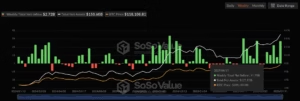The rise of tokenized US Treasurys in the world of cryptocurrency is reshaping the landscape of financial markets. As these digital assets become increasingly utilized as collateral in leveraged trading, they introduce new and complex risk vectors that can impact both traditional finance and decentralized finance (DeFi) protocols.
Tokenization is the process of converting physical, real-world assets into digital tokens on a blockchain. By employing tokenized US government debt, traders gain access to a form of collateral that can be compared to money market fund shares. Currently, the market capitalization of tokenized US Treasurys is nearly $7.4 billion.
According to Moody’s report from June, while short-term liquidity funds generally fall into the low-risk category, they are not without their inherent risks. Traditional risks such as credit and liquidity issues remain, but tokenization adds additional layers of complexity. One significant risk is linked to the concept of loan-to-value (LTV) ratios in leveraged trading. If the value of posted collateral drops below a set threshold, traders face automatic liquidation or must add more collateral to hold their positions, raising the stakes for all involved.
Prominent crypto exchanges, including Deribit and Crypto.com, have embraced this trend, supporting users to utilize tokenized US Treasury funds for leveraged trades. This adaptation aligns with the broader evolution of finance, where institutional demand for these digital assets illustrates their value and potential impact. However, it also raises alarms regarding the systemic risks associated with their integration in financial markets.
As noted in a presentation to the Treasury Borrowing Advisory Committee, the expanding use of tokenization presents pathways for volatility to flow into global markets. The Treasury warned that as the scale of tokenized assets grows, issues such as deleveraging and fire sales could escalate, causing rapid consequences across linked financial systems.
Furthermore, tokenized Treasurys encounter multiple external risk factors, including fluctuations in the US dollar, geopolitical upheavals, and governmental fiscal policies. The founder of Zumo, Nick Jones, has highlighted the necessity for robust risk management strategies to navigate this perilous terrain.
The growing sentiment among investors points towards a transition where traditional assets like gold, real estate, and energy commodities are also being tokenized as potential alternatives to safeguard value in a tumultuous market atmosphere. As interest mounts in stable yield-bearing assets, the trajectory of tokenized real-world assets (RWAs) appears promising.
In summary, while the innovation surrounding tokenized Treasurys offers a strategic advantage for institutions looking to optimize capital allocation, the associated risks warrant cautious observation and informed management. As traditional finance and DeFi systems begin to overlap more comprehensively, understanding these complexities will be crucial for every stakeholder involved.







